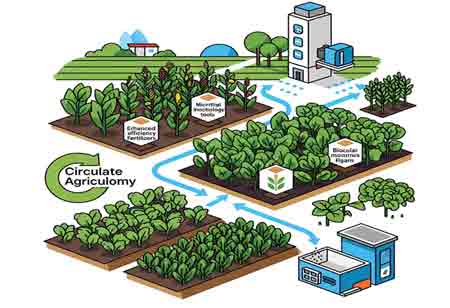Thank you for Subscribing to Agri Business Review Weekly Brief
Revolutionizing Plant Nutrition with Smart Agriculture
The shift toward sustainable plant nutrition is being driven by precision agriculture, advanced fertilizers, biotechnology, and circular economy principles. This integrated approach aims to meet growing global food demands while safeguarding the environment.

By
Agri Business Review | Friday, October 17, 2025
Stay ahead of the industry with exclusive feature stories on the top companies, expert insights and the latest news delivered straight to your inbox. Subscribe today.
The global agricultural sector is under increasing pressure to adopt sustainable practices that can feed a growing population without compromising environmental health. Central to this transformation is sustainable plant nutrition—a dynamic blend of innovative strategies aimed at optimizing nutrient use, reducing ecological impact, and strengthening the resilience and productivity of farming systems.
One of the most significant trends is the ascendancy of precision agriculture. This paradigm leverages advanced data analytics, remote sensing, and automated systems to tailor nutrient application to the precise needs of individual plants or specific zones within a field. Satellite and drone imagery provide real-time insights into crop health, soil moisture, and nutrient status, enabling farmers to identify spatial variability and apply inputs with unprecedented accuracy. Variable Rate Technology (VRT), guided by GPS, ensures that fertilizers are dispensed in optimal quantities, reducing waste and preventing over-application. On-site soil sensors and weather stations further enhance this data stream, enabling adjustments to irrigation and nutrient delivery based on prevailing environmental conditions. The integration of artificial intelligence and machine learning is making these systems even more sophisticated, with AI-driven models providing personalized recommendations for nutrient management and predictive analytics for optimal application timing.
Closely intertwined with precision agriculture is the remarkable progress in enhanced efficiency fertilizers (EEFs). These formulations are designed to optimize nutrient uptake by plants and minimize environmental losses. Slow-release fertilizers (SRFs) and controlled-release fertilizers (CRFs) are at the forefront of this innovation. SRFs gradually release nutrients over an extended period, often weeks or months, ensuring a consistent supply and reducing the need for frequent reapplication. CRFs, on the other hand, employ sophisticated coatings that dictate the rate of nutrient release based on environmental factors, such as temperature and moisture. This controlled release of nutrients significantly improves nutrient use efficiency (NUE), resulting in improved crop growth, higher yields, and a notable reduction in nutrient runoff and leaching into water bodies. The development of biodegradable coatings for CRFs further amplifies their environmental benefits, aligning with principles of a circular economy.
The role of biotechnology in sustainable plant nutrition continues to expand. Gene editing technologies are enabling the development of crop varieties with enhanced nutrient uptake capabilities and improved nutrient use efficiency. By precisely modifying plant genomes, researchers are fostering traits such as more robust root systems, increased nutrient absorption from the soil, and improved internal nutrient cycling. This not only reduces the reliance on external nutrient inputs but also contributes to the development of crops that are more resilient to nutrient deficiencies. Furthermore, biotechnology plays a crucial role in improving the nutritional content of crops through biofortification, addressing global dietary needs with nutrient-dense produce.
Microbial inoculants are emerging as a cornerstone of sustainable plant nutrition. These beneficial microorganisms, including bacteria, fungi, and algae, are applied to the soil or directly to plants to enhance nutrient availability and uptake. Nitrogen-fixing bacteria, for instance, convert atmospheric nitrogen into a form usable by plants, reducing the need for synthetic nitrogen fertilizers. Phosphate-solubilizing bacteria make insoluble phosphorus in the soil accessible to plants. Beyond direct nutrient mobilization, microbial inoculants contribute to overall soil health by improving soil structure, enhancing organic matter decomposition, and promoting the growth of beneficial microbial communities. This biological approach to nutrient management offers a significant pathway to reduce the environmental footprint associated with conventional fertilization.
The principles of the circular economy are increasingly being integrated into plant nutrient solutions. This involves a fundamental shift from a linear "take-make-dispose" model to one that emphasizes resource recovery and reuse. Nutrient recycling from various waste streams, including agricultural byproducts and municipal organic waste, is gaining traction. Technologies for recovering phosphorus from sewage sludge ash and other residues are being refined, transforming what was once considered waste into valuable plant nutrients. Similarly, the capture and reuse of carbon dioxide emitted from fertilizer production facilities exemplify a commitment to circularity, turning a byproduct into a resource for other industries while reducing greenhouse gas emissions. The re-evaluation and beneficial application of materials like phosphogypsum, a byproduct of phosphate fertilizer production, are further testaments to this circular approach, converting a historical waste product into a valuable resource for agriculture and other sectors.
Beyond these core advancements, other innovative practices are contributing to the sustainable plant nutrition landscape. Soilless cultivation systems, such as hydroponics and aeroponics, are gaining momentum, particularly in urban and vertical farming environments. These systems offer precise control over nutrient delivery, significantly reducing water usage and nutrient runoff. The development of peat-free and biodegradable growing media is another step towards environmental stewardship in these controlled environments. Furthermore, agrivoltaic systems, which integrate solar energy generation with crop cultivation, offer a dual benefit, optimizing land use and influencing nutrient management strategies in novel ways.
The industry's trajectory is clearly towards an integrated, data-driven, and biologically enhanced approach to plant nutrition. The ongoing research and development in areas like precision nutrient management, novel fertilizer formulations, biotechnological crop improvements, microbial solutions, and circular economy principles are collectively paving the way for a more resilient, productive, and environmentally conscious agricultural future. The emphasis is firmly on optimizing nutrient use efficiency, minimizing environmental impact, and fostering the long-term health of agricultural ecosystems, ensuring food security for generations to come.





